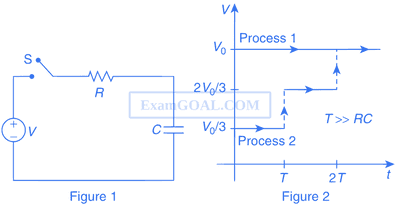Mechanics
Units & Measurements
Fill in the BlanksNumericalMCQ (Single Correct Answer)MCQ (Multiple Correct Answer)SubjectiveMotion
Fill in the BlanksNumericalMCQ (Single Correct Answer)MCQ (Multiple Correct Answer)SubjectiveTrue of FalseElectricity
Optics
Wave Motion
MCQ (Multiple Correct Answer)Modern Physics
1
JEE Advanced 2023 Paper 1 Online
MCQ (Single Correct Answer)
+3
-1
A container has a base of $50 \mathrm{~cm} \times 5 \mathrm{~cm}$ and height $50 \mathrm{~cm}$, as shown in the figure. It has two parallel electrically conducting walls each of area $50 \mathrm{~cm} \times 50 \mathrm{~cm}$. The remaining walls of the container are thin and non-conducting. The container is being filled with a liquid of dielectric constant 3 at a uniform rate of $250 \mathrm{~cm}^3 \mathrm{~s}^{-1}$. What is the value of the capacitance of the container after 10 seconds?
[Given: Permittivity of free space $\epsilon_0=9 \times 10^{-12} \mathrm{C}^2 \mathrm{~N}^{-1} \mathrm{~m}^{-2}$, the effects of the non-conducting walls on the capacitance are negligible]

[Given: Permittivity of free space $\epsilon_0=9 \times 10^{-12} \mathrm{C}^2 \mathrm{~N}^{-1} \mathrm{~m}^{-2}$, the effects of the non-conducting walls on the capacitance are negligible]

2
JEE Advanced 2017 Paper 2 Offline
MCQ (Single Correct Answer)
+3
-0
Consider a simple RC circuit as shown in Figure 1.
Process 1 : In the circuit the switch S is closed at t = 0 and the capacitor is fully charged to voltage V0 (i.e. charging continues for time T >> RC). In the process some dissipation (ED) occurs across the resistance R. The amount of energy finally stored in the fully charged capacitor is EC.
Process 2 : In a different process the voltage is first set to $${{{V_0}} \over 3}$$ and maintained for a charging time T >> RC. Then, the voltage is raised to $${{2{V_0}} \over 3}$$ without discharging the capacitor and again maintained for a time T >> RC. The process is repeated one more time by raising the voltage to V0 and the capacitor is charged to the same final voltage V0 as in Process 1.
These two processes are depicted in Figure 2.

Process 1 : In the circuit the switch S is closed at t = 0 and the capacitor is fully charged to voltage V0 (i.e. charging continues for time T >> RC). In the process some dissipation (ED) occurs across the resistance R. The amount of energy finally stored in the fully charged capacitor is EC.
Process 2 : In a different process the voltage is first set to $${{{V_0}} \over 3}$$ and maintained for a charging time T >> RC. Then, the voltage is raised to $${{2{V_0}} \over 3}$$ without discharging the capacitor and again maintained for a time T >> RC. The process is repeated one more time by raising the voltage to V0 and the capacitor is charged to the same final voltage V0 as in Process 1.
These two processes are depicted in Figure 2.

In Process 1, the energy stored in the capacitor EC and heat dissipated across resistance ED are related by
3
JEE Advanced 2017 Paper 2 Offline
MCQ (Single Correct Answer)
+3
-0
Consider a simple RC circuit as shown in Figure 1.
Process 1 : In the circuit the switch S is closed at t = 0 and the capacitor is fully charged to voltage V0 (i.e. charging continues for time T >> RC). In the process some dissipation (ED) occurs across the resistance R. The amount of energy finally stored in the fully charged capacitor is EC.
Process 2 : In a different process the voltage is first set to $${{{V_0}} \over 3}$$ and maintained for a charging time T >> RC. Then, the voltage is raised to $${{2{V_0}} \over 3}$$ without discharging the capacitor and again maintained for a time T >> RC. The process is repeated one more time by raising the voltage to V0 and the capacitor is charged to the same final voltage V0 as in Process 1.
These two processes are depicted in Figure 2.

Process 1 : In the circuit the switch S is closed at t = 0 and the capacitor is fully charged to voltage V0 (i.e. charging continues for time T >> RC). In the process some dissipation (ED) occurs across the resistance R. The amount of energy finally stored in the fully charged capacitor is EC.
Process 2 : In a different process the voltage is first set to $${{{V_0}} \over 3}$$ and maintained for a charging time T >> RC. Then, the voltage is raised to $${{2{V_0}} \over 3}$$ without discharging the capacitor and again maintained for a time T >> RC. The process is repeated one more time by raising the voltage to V0 and the capacitor is charged to the same final voltage V0 as in Process 1.
These two processes are depicted in Figure 2.

In Process 2, total energy dissipated across the resistance ED is
4
IIT-JEE 2012 Paper 2 Offline
MCQ (Single Correct Answer)
+4
-1
In the given circuit, a charge of $$+80$$ $$\mu C$$ is given to the upper plate of the $$4$$ $$\mu F$$ capacitor. Then in the steady state, the charge on the upper plate of the $$3$$ $$\mu F$$ capacitor is


Questions Asked from MCQ (Single Correct Answer)
JEE Advanced Subjects
Physics
Mechanics
Electricity
Modern Physics
Chemistry
Physical Chemistry
Inorganic Chemistry
Mathematics
Algebra
Trigonometry
Coordinate Geometry